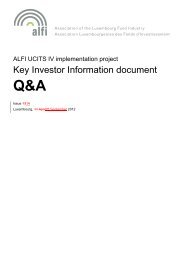Real Estate Investment Funds: Financial reporting - Alfi
Real Estate Investment Funds: Financial reporting - Alfi
Real Estate Investment Funds: Financial reporting - Alfi
You also want an ePaper? Increase the reach of your titles
YUMPU automatically turns print PDFs into web optimized ePapers that Google loves.
what options do FOREFS have in respect of the issues identified above?<br />
The above factors negatively impact the ability to calculate an accurate Fund NAV of<br />
a FOREF. Broadly speaking, management of such FOREFs has three main options in<br />
respect of dealing with these with regard to the calculation of Fund NAVs and fund<br />
financial <strong>reporting</strong>:<br />
1. Delay <strong>reporting</strong> of<br />
NAVs/financial<br />
statements to collect<br />
more up-to-date<br />
information<br />
a. Management should strongly consider<br />
delaying <strong>reporting</strong> in order to collect as much<br />
possible up-to-date and accurate information<br />
from "investee" funds on which to base the<br />
valuations. This may include, for example,<br />
delaying <strong>reporting</strong> until audited financial<br />
statements of the "investee" funds have been<br />
received so that more comfort exists with<br />
regard to valuations and going concern/<br />
liquidity issues facing the "investee" funds<br />
and, therefore, management of such funds<br />
have more support to base their conclusions<br />
for the Fund NAV. Further examples of<br />
additional information that could be received<br />
are listed in Chapter VIII.1 above.<br />
b. In such cases, management should be aware<br />
of their deadlines to deliver <strong>reporting</strong>, both<br />
on a contractual and regulatory basis. For<br />
example, SIFs in Luxembourg are normally<br />
required by law to deliver their audited<br />
financial statements within six months of<br />
their year end, so any delay beyond this date<br />
may require an approval from the investors<br />
and the CSSF.<br />
2. Suspend issuance of<br />
the FOF NAV<br />
a. Management may choose to suspend<br />
issuance of the FOREF NAV until such time<br />
that management believes that the Fund<br />
NAV can be produced with an appropriate<br />
level of accuracy.<br />
b. If management judges that, due to current<br />
market conditions, it is not possible to<br />
calculate a reliable Fund NAV then<br />
consideration may need to be given to<br />
suspending the FOREFs NAV. This is<br />
particularly important with regard to<br />
open-ended funds where Fund NAVs not<br />
only are used for information purposes but<br />
are also used to price issues and redemptions<br />
and thus effect the distribution of value in<br />
the FOREF between investors.<br />
c. In these circumstances the following options<br />
could be considered to the extent that they<br />
are commercially viable and in accordance<br />
with the FOREFs governing documentation<br />
and regulatory requirements.<br />
d. Deferring issues and redemptions until a<br />
Fund NAV (pricing NAV if different) can be<br />
reliably calculated. It may well be, however,<br />
that this is not commercially viable – the<br />
fund may need, for instance, to contribute<br />
committed capital to investee funds to<br />
protect value and avoid defaulting; investors’<br />
capital may need to be drawn to do this.<br />
e. Arranging short term funding in order to<br />
finance operations, to avoid the need to price<br />
new issues of units/shares.<br />
f. Issuing/redeeming units but delaying pricing<br />
these transactions until a more reliable Fund<br />
NAV is available. This is a possible solution,<br />
subject to the regulatory framework of the<br />
fund, where management wants to draw<br />
capital from investors and also provide them<br />
with liquidity.<br />
36

















